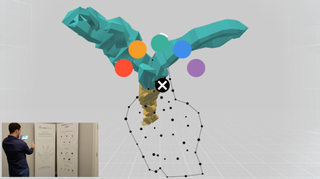ManoMotion Releases Camera-Based Hand Gesture Tracking Technology, Free SDK Available Now

ManoMotion revealed a camera-based 3D real-time hand gesture tracking technology that lets you see your real hands in VR, AR, and MR experiences on mobile devices.
ManoMotion is a 7-year-old computer vision company based in Stockholm, Sweden that specializes in solving camera-based gesture recognition. Daniel Carlman, co-founder and CEO at ManoMotion, told Tom’s Hardware that his company “decided to track the most difficult body part first,” and it's doing so with great success. ManoMotiion’s technology can recognize and track up to two million gestures in real time.
ManoMotion sees its gesture tracking technology as a competitor to Leap Motion’s hand tracking technology, but ManoMotion believes it has a key advantage of Leap Motion; its technology works with any RGB camera. Leap Motion fancies itself a software company first and foremost, but ManoMotion has a point; Leap Motion’s technology relies on a special camera. ManoMotion’s technology is camera agnostic.
ManoMotion developed its 3D gesture tracking technology to work on standard 2D cameras. Carlman said that his company’s software could determine depth with sub-centimeter accuracy, and it recognizes 17- degrees of freedom in your hands and fingers. ManoMotion said the complex structure of the human hand offers 27-degrees of freedom. ManoMotion’s framework currently recognizes 2 million hand gestures in real time, and it’s the company’s intention to improve its algorithms over time to recognize all 27-degrees of motion so the gesture list should grow substantially. ManoMotion’s software also recognizes dynamic gestures, such as swiping, clicking, and grabbing.

ManoMotion said that its 3D hand gesture tracking software is lightweight and doesn’t require much CPU, GPU, memory, or battery power to operate. ManoMotion’s software works well on older hardware, too. Carlman told us that ManoMotion tested its gesture tracking technology on Samsung’s Galaxy S6 and the older smartphone recognized gestures with 15ms of motion to photon latency. Newer hardware should offer better performance figures.
ManoMotion’s hand gesture technology works on Android and iOS devices. The SDK allows developers to create augmented reality experiences for smartphones with Unity. Smartphone AR experiences that feature ManoMotion’s gesture tracking technology can bring a digital facsimile of your real hands into the digital experience on your smartphone’s screen.

ManoMotion’s technology can also be adapted for virtual reality and mixed reality use cases. Carlman said the SDK supports Google’s virtual reality platforms, too. Many Google Cardboard and knock-off VR headsets offer camera pass-through. Any of those HMDs would allow the use of ManoMotion’s technology. Carlman said the SDK also support Google’s Daydream platform, though, that support will remain dormant for the time being. Google’s Daydream View headset doesn’t include a hole on the faceplate for the camera, but Carlman said Google assured ManoMotion that future Daydream headsets would offer a camera option.
Stay on the Cutting Edge
Join the experts who read Tom's Hardware for the inside track on enthusiast PC tech news — and have for over 25 years. We'll send breaking news and in-depth reviews of CPUs, GPUs, AI, maker hardware and more straight to your inbox.
ManoMotion also has plans to embrace Microsoft’s Mixed Reality platform. The lower end Microsoft MR headsets, such as Acer’s MR dev kits, don’t include pass-through cameras, so don’t expect Windows VR headsets to get ManoMotion support anytime soon, by the HoloLens is on the menu. ManoMotion said that it would have more to say about HoloLens support in the coming weeks.
ManoMotion used to offer its technology on a case-by-case basis to select customers. Now, the company is offering an SDK to anyone who’s interested in testing the technology. The company offers its SDK with a “freemium” licensing model; the software is free to use for limited personal projects and prototyping, but if you want to commercialize your product you’ll have to work out a licensing agreement. ManoMotion offers licensing packages on a credit system that lets you scale your license volume as needed.
The ManoMotion SDK is available now from the ManoMotion website. For more information about the licensing options, you can register for the company’s developer program.
Update, June 1, 2017, 3:50pm PT: fixed a broken video link.
Kevin Carbotte is a contributing writer for Tom's Hardware who primarily covers VR and AR hardware. He has been writing for us for more than four years.
Most Popular

